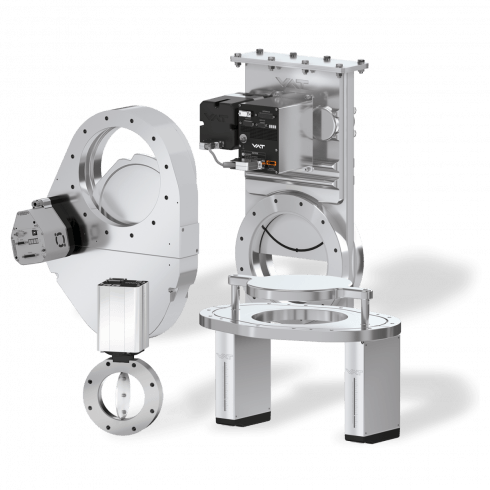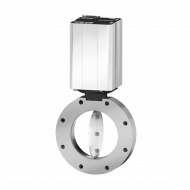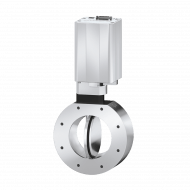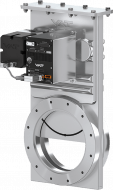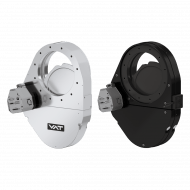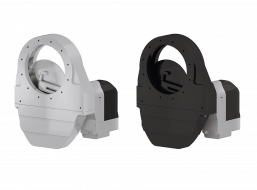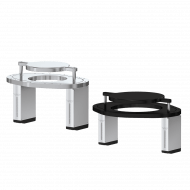FAQ Vacuum Control Valves
What are vacuum control valves?
Vacuum control valves, unlike vacuum isolation valves whose function is limited to full opening and closing, allow control of volume flows. This is usually done by narrowing or widening the valve passage. The control range varies depending on the design principle of the control valve. This is also referred to as the available conductance spectrum. Valves with a very large conductance spectrum generally allow finer volume control than valves with a small conductance spectrum. However, the design principle and the type of drive are also decisive for the fineness and precision of the valve control. Vacuum control valves are predominantly electrically driven, since the electric drive usually allows very fine and fast position changes of the valve plate. Both are crucial for precise control. In addition to electrically driven control valves, however, there are also pneumatic solutions that e.g. move to mechanically predefined control positions, or manual solutions. Vacuum control valves are also available as pure control valves without an isolation function, i.e. they never seal completely and always allow a minimum residual volume flow, or as control and isolation valves that also offer complete interruption of the volume flow.
Vacuum control valves are available in very different designs, as control requirements for vacuum systems can vary greatly. The following criteria are therefore decisive when selecting a vacuum control valve:
1) The level of the maximum differential pressure at which the valve is to control. This is not necessarily the maximum differential pressure that the valve can withstand when closed, if it also has an isolation function.
2) The size of the required conductance spectrum, the control range.
3) The size of the flow rate
4) The speed with which changes in the volume flow are to be carried out
5) The resistance to by-products in the volume flow or to aggressive media in general.
6) The sensitivity to flow changes e.g. turbulence caused by the control process.
7) The sensitivity to particles that may be emitted through the valve.
8) The ambient temperatures at which the valve is to be used and at which it is to control.
9) The type of controllability as linear flow change or dynamic change, where the control speed can be controlled independently of the position of the valve plate in a so-called control profile.
Vacuum control valves are available in very different designs, as control requirements for vacuum systems can vary greatly. The following criteria are therefore decisive when selecting a vacuum control valve:
1) The level of the maximum differential pressure at which the valve is to control. This is not necessarily the maximum differential pressure that the valve can withstand when closed, if it also has an isolation function.
2) The size of the required conductance spectrum, the control range.
3) The size of the flow rate
4) The speed with which changes in the volume flow are to be carried out
5) The resistance to by-products in the volume flow or to aggressive media in general.
6) The sensitivity to flow changes e.g. turbulence caused by the control process.
7) The sensitivity to particles that may be emitted through the valve.
8) The ambient temperatures at which the valve is to be used and at which it is to control.
9) The type of controllability as linear flow change or dynamic change, where the control speed can be controlled independently of the position of the valve plate in a so-called control profile.
What are the variants of vacuum control valves?
Butterfly Control Valves
Butterfly control valves allow outstandingly precise and fast pressure control under all conditions. The plate acts as a throttling element and varies the conductance of the valve opening. The pressure controller integrated in the butterfly valve calculates the required plate position, optimizing the achievement of the desired pressure.
HV Butterfly Control and Isolation Valves
HV butterfly control and isolation valves allow outstanding pressure control under all conditions. The plate acts as a throttling element and varies the conductance of the valve opening. The pressure controller integrated in the valve calculates the required plate position, optimizing the achievement of the desired pressure.
The additional isolation function of the valve avoids the characteristically higher seal wear of butterfly valves. An off-center plate shaft and the special geometry of the valve body and seal seat minimize seal friction while increasing seal performance.
HV Angle Control Valve
HV angle control valves are designed for scenarios with particularly high pressure and high temperatures, such as ALD or CVD. In doing so, HV angle control valves deliver exceptionally precise pressure control performance even at maximum operating temperatures.
HV Control Gate Valves
HV gate control valves are recommended for high cycle vacuum control and isolation in standard vacuum processes such as sputtering and etching processes in semiconductor production. HV control gate valves meet standard requirements for durability, modularity and ease of maintenance and also impress with high availability and low operating costs.
UHV Control Gate Valves
UHV control gate valves guarantee precise control and isolation in ultra-high vacuum processes, such as "sputtering" or EUV in semiconductor production. UHV control gate valves meet the standard requirements for durability, modularity and ease of maintenance and also impress with high availability and low operating costs.
HV Pendulum Control Valves
HV pendulum control valves offer optimized downstream pressure control and vacuum isolation especially for semiconductor and display production. The HV pendulum control valve offers a wide control range over a broad conductance spectrum.
Flow-Symmetrical Control Valves
Flow-symmetrical control valves ensure maximum quality and productivity with flow-optimized pressure control and can also be used as downstream control and isolation valves.
HV Control and Isolation Valve Combination System
HV control and isolation valve combination systems combine the best features of a control and an isolation valve. The effective combination of the two valve technologies thus enables a high-performance combination system in a compact design.
Butterfly control valves allow outstandingly precise and fast pressure control under all conditions. The plate acts as a throttling element and varies the conductance of the valve opening. The pressure controller integrated in the butterfly valve calculates the required plate position, optimizing the achievement of the desired pressure.
HV Butterfly Control and Isolation Valves
HV butterfly control and isolation valves allow outstanding pressure control under all conditions. The plate acts as a throttling element and varies the conductance of the valve opening. The pressure controller integrated in the valve calculates the required plate position, optimizing the achievement of the desired pressure.
The additional isolation function of the valve avoids the characteristically higher seal wear of butterfly valves. An off-center plate shaft and the special geometry of the valve body and seal seat minimize seal friction while increasing seal performance.
HV Angle Control Valve
HV angle control valves are designed for scenarios with particularly high pressure and high temperatures, such as ALD or CVD. In doing so, HV angle control valves deliver exceptionally precise pressure control performance even at maximum operating temperatures.
HV Control Gate Valves
HV gate control valves are recommended for high cycle vacuum control and isolation in standard vacuum processes such as sputtering and etching processes in semiconductor production. HV control gate valves meet standard requirements for durability, modularity and ease of maintenance and also impress with high availability and low operating costs.
UHV Control Gate Valves
UHV control gate valves guarantee precise control and isolation in ultra-high vacuum processes, such as "sputtering" or EUV in semiconductor production. UHV control gate valves meet the standard requirements for durability, modularity and ease of maintenance and also impress with high availability and low operating costs.
HV Pendulum Control Valves
HV pendulum control valves offer optimized downstream pressure control and vacuum isolation especially for semiconductor and display production. The HV pendulum control valve offers a wide control range over a broad conductance spectrum.
Flow-Symmetrical Control Valves
Flow-symmetrical control valves ensure maximum quality and productivity with flow-optimized pressure control and can also be used as downstream control and isolation valves.
HV Control and Isolation Valve Combination System
HV control and isolation valve combination systems combine the best features of a control and an isolation valve. The effective combination of the two valve technologies thus enables a high-performance combination system in a compact design.
What are the primary applications of vacuum control valves?
Basically, vacuum control valves are used wherever precise control of the vacuum level is required. This is necessary, for example, for fine control in CVD and ALD processes. In semiconductor and display production, they are used in sputtering and etching processes. Likewise, vacuum control valves are used in ultra-high vacuum scenarios such as EUV.
For which vacuum levels are vacuum control valves particularly suitable?
Vacuum control valves are primarily used in high vacuum scenarios. However, via special specifications (UHV control gate valves), control valves are also used in ultra-high vacuum processes.
What distinguishes VAT vacuum control valves?
With their robust design, VAT vacuum control valves are particularly suitable for harsh downstream processes with possible particles in the gas stream. This means that the control valves remain fully functional even in the presence of high particle loads and deposits. Furthermore, VAT vacuum control valves allow extensive specific adaptations and are compatible with customer-specific flanges and additional special equipment. In addition, the reduced and simple maintenance as well as the low operating costs are convincing.
VAT vacuum control valves have outstanding properties for particle prevention, as the contact-free movement of the closing plate and optimally damped opening and closing movements eliminate the shocks and vibrations common with conventional valves. With various locking technologies, VAT vacuum control valves also guarantee that the vacuum is maintained safely even if the compressed air or power supply fails.
VAT vacuum control valves have outstanding properties for particle prevention, as the contact-free movement of the closing plate and optimally damped opening and closing movements eliminate the shocks and vibrations common with conventional valves. With various locking technologies, VAT vacuum control valves also guarantee that the vacuum is maintained safely even if the compressed air or power supply fails.

